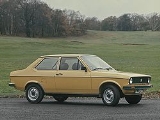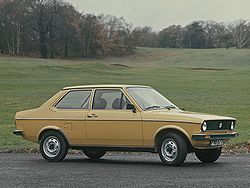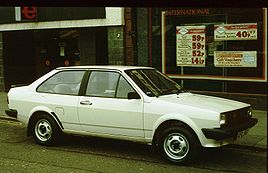
Volkswagen Derby
Encyclopedia


Three-box styling
Three-box design is a broad automotive styling term describing a coupé, sedan, notchback or hatchback where — when viewed in profile — principal volumes are articulated into three separate compartments or boxes: engine, passenger and cargo....
version of the Volkswagen Polo
Volkswagen Polo
The Volkswagen Polo is a supermini car manufactured by Volkswagen. It is sold in Europe and other markets worldwide in hatchback, saloon, coupé and estate variants....
supermini
Supermini car
A supermini is a British term that describes automobiles larger than a city car but smaller than a small family car. This car class is also known as the B-segment across Europe, and as subcompact in North America....
, produced by the German automobile maker Volkswagen
Volkswagen
Volkswagen is a German automobile manufacturer and is the original and biggest-selling marque of the Volkswagen Group, which now also owns the Audi, Bentley, Bugatti, Lamborghini, SEAT, and Škoda marques and the truck manufacturer Scania.Volkswagen means "people's car" in German, where it is...
, between 1977 and 1981.
With 72,412 sold in 1977 alone the car was initially popular, outselling the Polo sister model in that year, but sales quickly tailed off in subsequent years.
During 1981, Volkswagen introduced the second generation Polo and the second generation Derby; in 1984 the Derby name was dropped and the saloon version of the Polo became the Polo Classic.
Most parts of the Derby are interchangeable with the Mk1 Polo, and many drivetrain components are compatible with the Mk2 models. Body parts at the rear and also the rear window are different and are directly attributable to the original design version of this vehicle, which was intended to be marketed as the Audi 60. Lights of the early version are the same as the Mk1 Polo and the car which began this design: the Audi 50
Audi 50
The Audi 50 is a supermini produced by German automaker Audi from 1974 to 1978 and sold only in Europe. Introduced two or three years after the Italian Fiat 127 and the French Renault 5, the model was seen at the time as Germany's first home grown entrant in Europe's emerging "supermini"...
, which dates to just before the full merger of Audi and Volkswagen.
This was 1979 Semperit Irish Car of the Year
Semperit Irish Car of the Year
The Semperit Irish Car of the Year award was established in 1978. It is organised and judged by the Irish Motoring Writers Association . It is sponsored by tyre manufactuer Semperit and specifically by their brand - 'Semperit'....
in Ireland.
Versions available
In Europe, the Derby was available with 0.9-litre (895 cc), 1.1-litre (1,093 cc) and 1.3-litre (1,272 cc) four-cylinder engines, with 40, 50 and 60 bhp respectively. The Derby Formel E ("Formula E"), offered in 1981 only, was an economy-optimised Derby featuring, among other things, a longer ratio gearbox, automatic engine turn-off when idling and a high compression version on the 1.1 L engine that demanded super instead of regular petrol. The Formel E concept was also available on other contemporary VW and Audi models.The following versions were available:
- 900 L
- 1100 LS
- 1100 LX
- 1100 CLS
- 1300 LS
- 1300 GL
- 1300 GLS
- 1100 Formel E
In 1980, the Derby underwent a face lift together with the Polo. The restyle attempted to separate the styling of the Polo and the Derby more significantly, which also brought the styling of the Derby into line with its bigger counterpart the Volkswagen Jetta. These revisions included rectangular headlamps, a restyled grille and plastic bumpers, together with some interior changes including a new dashboard and instrumentation taken from the Mk1 Golf.
In 1984, the Derby was re-badged as the Polo Classic in Europe, and the Derby's unique squared headlamp front end, which had been carried over from the Mk1, was replaced with standard Polo equipment.
In the UK, the Derby name was dropped with the Mk1, and the Polo Classic name was used from the Mk2's inception. However, early Polo Classics still retained the Derby styling. In turn, the "Classic" branding for the saloon was dropped in 1987 which meant that the Polo and Derby integration was complete.
In 1991, the Polo saloon was withdrawn and would not return until 1996, when a version based on a badge-engineered SEAT Ibiza/Cordoba platform was launched. This version was known as the VW Derby in Mexico.
Marketing
This model was not sold outside EuropeEurope
Europe is, by convention, one of the world's seven continents. Comprising the westernmost peninsula of Eurasia, Europe is generally 'divided' from Asia to its east by the watershed divides of the Ural and Caucasus Mountains, the Ural River, the Caspian and Black Seas, and the waterways connecting...
, although some parts of Eurasia did get the Derby – Turkey, Cyprus and Malta were the main export markets within Eurasia, also some parts of Eastern Europe bordering on Asia had this car. The name was used on a re-badged SEAT Cordoba
SEAT Córdoba
The first generation SEAT Córdoba was presented at the 1993 Frankfurt Motor Show and launched in the summer of the same year, penned by Italian designer Giorgetto Giugiaro and based on the chassis of the SEAT Ibiza Mk2 which would spawn the Volkswagen Polo Mk3 the following year.Its 1.4, 1.6, 1.8...
in Mexico (see section below): but marketed as the Volkswagen Polo Classic saloon in Eurasia.
South American Polo Classic
In Argentina Volkswagen marketed a face-lifted version of the 1999-2001 Polo Classic which as the Derby in Mexico and a Volkswagen CaddyVolkswagen Caddy
Released in 1980, the first Volkswagen Caddy is a coupe utility, and van based on the Volkswagen Group A1 platform, shared with the small family car Volkswagen Golf Mk1.Volkswagen Typ is:*147 = LHD*148 = RHD-Caddy debuts internationally as a Rabbit:...
the SEAT Inca
SEAT Inca
The SEAT Inca is a panel van, manufactured between 1996 and 2003. It was designed and assembled in Spain by SEAT, and based upon the SEAT Ibiza Mk2....
derived van which shares the same platform and front end styling as the South American Type 6K.
Volkswagen Derby in Mexico (1995–2009) and Volkswagen Van (2004–2009)
The VW Derby arrived to Mexico in late 1994 as a 1995 model and was imported from Spain until the end of the same year, model years 1996 and 1997 were assembled by Volkswagen de México with Spanish imported parts (In this first season, the Mexican sold Derby was a rebadged SEAT CórdobaSEAT Córdoba
The first generation SEAT Córdoba was presented at the 1993 Frankfurt Motor Show and launched in the summer of the same year, penned by Italian designer Giorgetto Giugiaro and based on the chassis of the SEAT Ibiza Mk2 which would spawn the Volkswagen Polo Mk3 the following year.Its 1.4, 1.6, 1.8...
. For the 1998 model year and until the 2002 model year, the Derby was imported again from Spain, but now it was the European Volkswagen Polo Classic with the 1.8 L engine with 90 hp and a fiv-espeed manual gearbox. For the 2000 model, the Derby had the same restyling (affecting windshield, dashboard and side mirrors) than in Europe. In 2002 the Derby began to be imported from Argentina initially as the "Derby Wolfsburg Edition" because production had already being stopped in Europe. In this new presentation the Derby had some modification in badges, headlights and a new version with the 2.0 L 115 hp engine. In the next few months the argentinian Derby was now the regular model in Trendline (1.8 L) and Sportline (2.0 L) trims. In the 2005 model year was refreshed and was a resemblance of the second facelift of the first generation SEAT Cordoba
SEAT Córdoba
The first generation SEAT Córdoba was presented at the 1993 Frankfurt Motor Show and launched in the summer of the same year, penned by Italian designer Giorgetto Giugiaro and based on the chassis of the SEAT Ibiza Mk2 which would spawn the Volkswagen Polo Mk3 the following year.Its 1.4, 1.6, 1.8...
but soon after as the competition in that segment grew the Derby began losing sales so bad that in the 2008 model year only 2,987 units were sold when in the early 2000s were sold in the worst years around 10,000 units. The Van was the same second generation Volkswagen Caddy
Volkswagen Caddy
Released in 1980, the first Volkswagen Caddy is a coupe utility, and van based on the Volkswagen Group A1 platform, shared with the small family car Volkswagen Golf Mk1.Volkswagen Typ is:*147 = LHD*148 = RHD-Caddy debuts internationally as a Rabbit:...
; in 2005 received the same facelift as the Derby and also was a poor seller so at the same time the Derby sedan was discontinued VW Mexico decided to drop it, too. In Argentina the Polo Classic has survived until the end of 2010. In most Latin American countries it was replaced by the new Volkswagen Voyage/Gol Sedan.
The 6K Polo Classic and 9K Caddy have been produced since 2000, although saloon versions of the Polo have not been sold in Europe since 2002. All face-lifted Type 6K/9K models are built in Argentina.
This model had a 1.8-litre engine, which was exclusive to South America, and not offered on the European Volkswagen Polo
Volkswagen Polo
The Volkswagen Polo is a supermini car manufactured by Volkswagen. It is sold in Europe and other markets worldwide in hatchback, saloon, coupé and estate variants....
saloon / estate.

